Will you okay a 4-month, $340,000 gen AI pilot if there is a >70% chance it will never see production?
We're not being pessimistic. While boardrooms buzz with excitement about intelligent automation and personalized customer experiences, a lot of AI initiatives quietly die between pilot and production. The gap isn't a lack of appetite or investment. It's a fundamental flaw in approach and knowhow.
This guide reveals why traditional AI adoption fails and how a production-first approach can accelerate AI adoption from experimentation to measurable business impact.
The Gen AI production crisis: AI adoption challenges
The statistics on enterprise AI adoption are sobering.
Gartner predicts that by 2025, 30% of current AI projects will be abandoned immediately after proof-of-concept. IDC research shows that only 15% of businesses successfully move AI projects beyond the pilot stage.
For every 20 AI initiatives your organization launches, only one will deliver sustained business value. The data reveals that there is more to AI than just plugging in APIs. You need strong AI software development nous.
The AI money sink
Despite these failure rates, enterprise investment in AI continues to accelerate. Gartner estimates that global Gen AI spending will reach $644 billion in 2025, a staggering 76% increase from the previous year. McKinsey notes that 71% of companies already use Gen AI in at least one business function, up from 65% in early 2024.
This creates a troubling disconnect. Organizations invest billions and experiment widely, but very few see meaningful returns. Money flows freely into pilots, yet production deployments remain elusive.
Why AI adoption fails
The reasons are surprisingly consistent across industries:
- Data and infrastructure gaps plague many initiatives. Organizations often lack clean, reliable data or systems needed to support production-grade AI. Without proper pipelines and scalable infrastructure, even technically sound models fail under real-world conditions.
- Business misalignment causes projects to launch without clear value propositions. Teams build impressive demonstrations that solve problems nobody has, while risk and compliance concerns derail promising projects before deployment.
- Organizational readiness remains critically low. McKinsey found that only 1% of leaders consider their companies mature in AI adoption, a clear signal that change management and cross-functional collaboration remain weak.
The result is a frustrating cycle where bold pilots rarely survive real-world complexity.
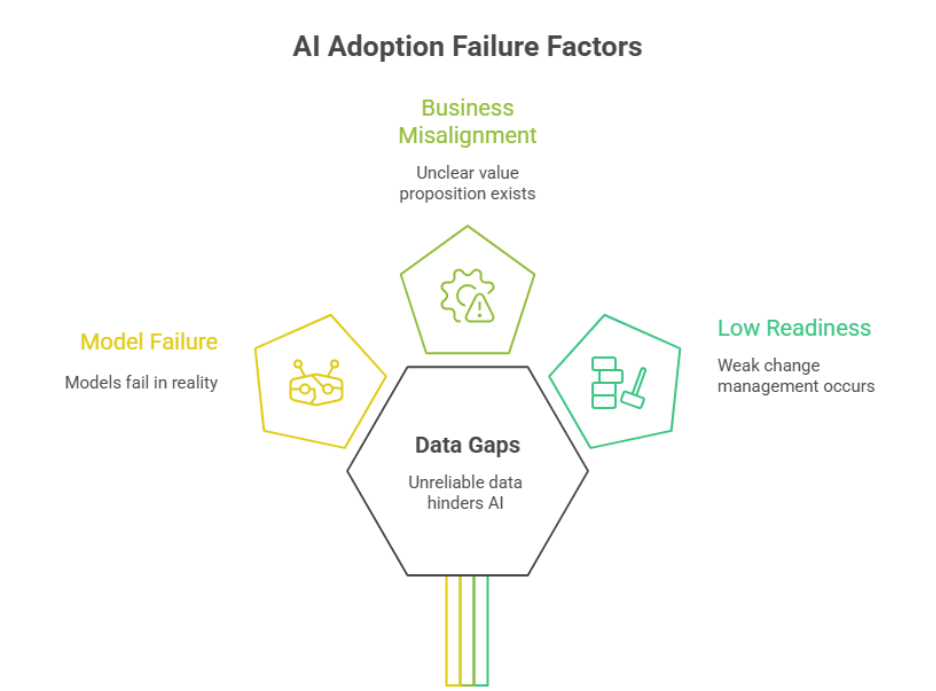
Breaking AI adoption barriers: common failure patterns and solutions
Understanding why AI projects fail requires examining the fundamental gap between proof-of-concept environments and production realities.
The POC-to-production divide
Proof-of-concept projects succeed in controlled settings with clean datasets and minimal integration requirements. Production environments are radically different. Models must perform reliably on messy, real-time data across complex enterprise systems, facing scalability challenges that don't appear during controlled testing.
POCs frequently overlook enterprise requirements for security, compliance, and auditability. Once these gaps surface during deployment, even technically excellent models fail.
The adoption gap phenomenon
The disconnect between stakeholder groups dooms many AI adoption efforts:
- Technical teams focus on model accuracy while business stakeholders prioritize user experience and measurable impact. Data scientists optimize F1 scores; executives want increased revenue or reduced costs.
- Lab performance doesn't predict operational success. High-performing models in controlled conditions may fail production requirements for response time, availability, and cost-effectiveness.
- Innovation timelines clash with business urgency. By the time a sophisticated model is ready, business priorities may have shifted entirely.
Six fatal failure patterns
Several recurring patterns explain why AI adoption stalls:
- Technical debt accumulation
Begins early when rushing to demonstrate POC value leads to shortcuts in code quality and architecture. These compromises compound into insurmountable obstacles.
- Scope creep dilutes focus
Initial success generates requests for additional features without proportional resources. Projects become bloated and unfocused.
- Inadequate monitoring
Leaves teams blind to model drift, performance degradation, or system failures before they impact operations.
- Poor change management undermines adoption
Insufficient user training results in low utilization, even when systems work technically.
- Insufficient testing
Creates brittle systems that fail under real-world conditions and edge cases.
- Poor architectural choices doom scalability
Teams often assume the largest models guarantee success, when simpler, well-tuned models might deliver better accuracy and efficiency at a lower cost.
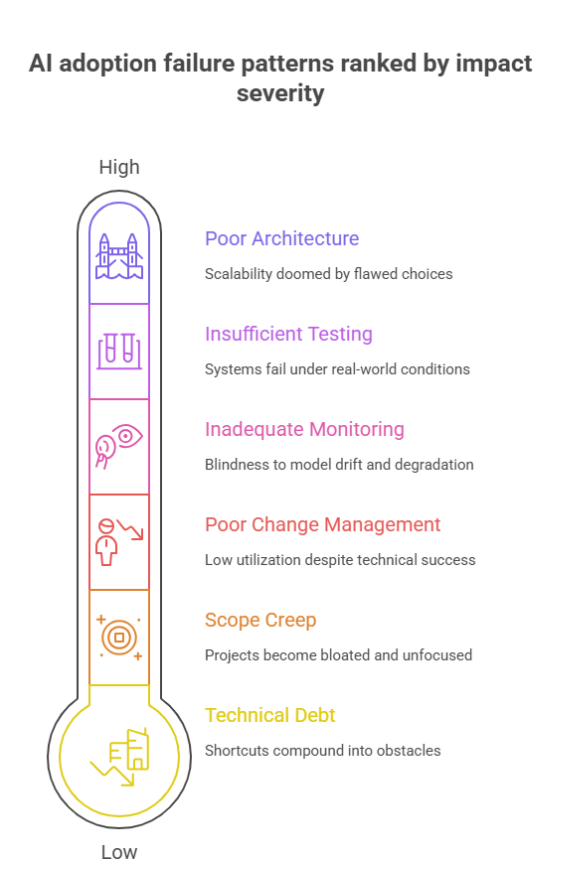
How to get AI adoption right?
The persistent pilot-to-production gap highlights the need for a fundamentally different approach. The problem isn't technical capability; it's flawed strategy.
The production-first paradigm
Traditional AI adoption treats production deployment as a downstream step, addressed only after pilots show technical promise. This creates blind spots around scalability, compliance, integration, and business value.
A production-first paradigm reverses this logic. Production considerations inform development from day one. Scalability, security, compliance, monitoring, and integration are foundational design inputs, not afterthoughts. Business value gets validated continuously rather than measured only after launch.
This reframes AI adoption entirely: instead of optimizing for short-term POC wins, organizations architect for long-term production success.
The four pillars of production success
Successful AI adoption consistently depends on four interconnected pillars:
Infrastructure readiness
Ensures enterprise-grade AI runs on scalable, secure systems from the start. Auto-scaling clusters handle dynamic workloads. Zero-trust architectures and compliance frameworks (SOC 2, HIPAA, GDPR) keep deployments audit-ready. Continuous monitoring tracks system health. Disaster recovery guarantees business continuity.
Data engineering excellence
Recognizes that AI is only as strong as its data. Automated validation and enrichment ensure reliability. Stream processing enables real-time responses. Clear data lineage maintains transparency. Privacy protections safeguard sensitive information. Poor data quality accounts for nearly half of failed implementations.
LLMOps
Extends beyond traditional MLOps to address unique challenges of large language models. Systematic prompt engineering drives domain-specific accuracy. Techniques like LoRA enable continuous adaptation without prohibitive costs. Comprehensive versioning ensures reproducibility. Guardrails and bias checks mitigate risks like hallucinations. Real-time monitoring detects drift before it damages outcomes.
Business integration
Ensures AI creates actual value. API-first design makes AI accessible across systems. Intuitive interfaces reduce adoption friction. Workflow integration embeds AI into decision-making processes. Structured change management empowers employees to trust and use AI effectively.
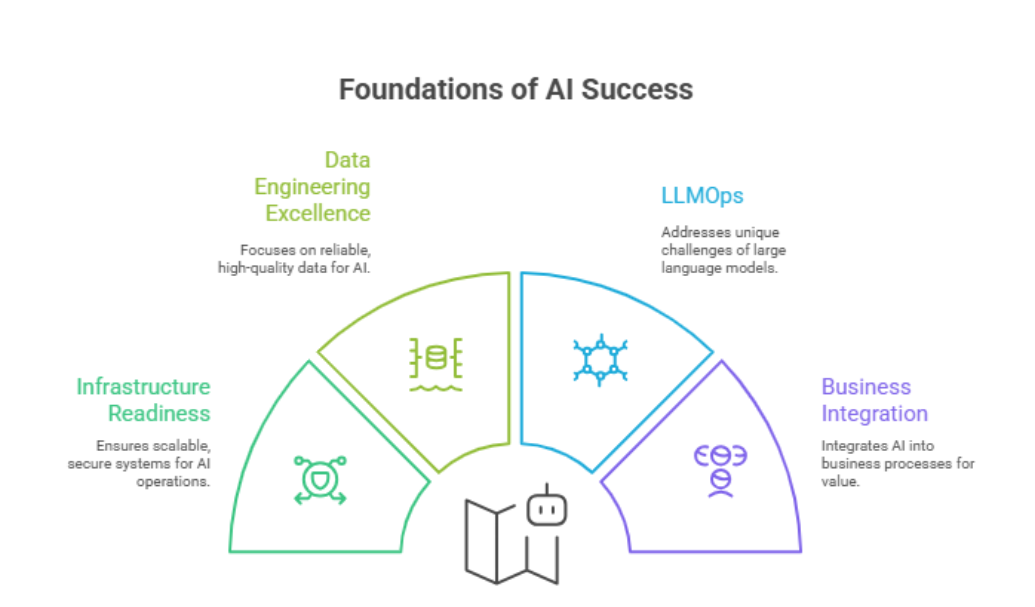
Introducing AI Matic: the production-first approach for enterprise AI adoption
AI Matic represents a change in how organizations approach AI adoption, from proof-of-concept thinking to production-ready builds from day one.
AI Matic is built for acceleration
AI Matic is a comprehensive acceleration framework developed to exclusively help companies pilot AI and move fast into production. It is a combination of development philosophy, best practices, and the complete technology stack required for enterprise AI adoption:
- A proven methodology that eliminates the 12-18 month experimentation cycle, enabling organizations to reach production in weeks.
- An architectural foundation with scalability, security, and compliance built in from the start.
- Pre-built accelerators for common enterprise use cases that dramatically reduce development time and deployment risk.
- Governance templates ensuring AI systems meet enterprise standards for security, compliance, and auditability.
- Deployment-ready code that streamlines integration and reduces failure chances during scaling.
The AI Matic architecture framework
AI Matic operates across five integrated layers:
- The infrastructure layer provides a scalable, secure, cloud-native foundation with auto-scaling capabilities, multi-region deployment, and comprehensive security controls.
- The data pipeline layer handles comprehensive data ingestion, cleansing, governance, and compliance, ensuring high-quality data feeds models with real-time processing.
- The model management layer provides complete lifecycle management for training, fine-tuning, monitoring, and updating large language models with automated pipelines.
- The API and integration layer ensure seamless enterprise connectivity through well-designed APIs and pre-built connectors.
- The observability layer delivers comprehensive performance monitoring, auditing, and compliance tracking with real-time visibility into system behavior and business impact.
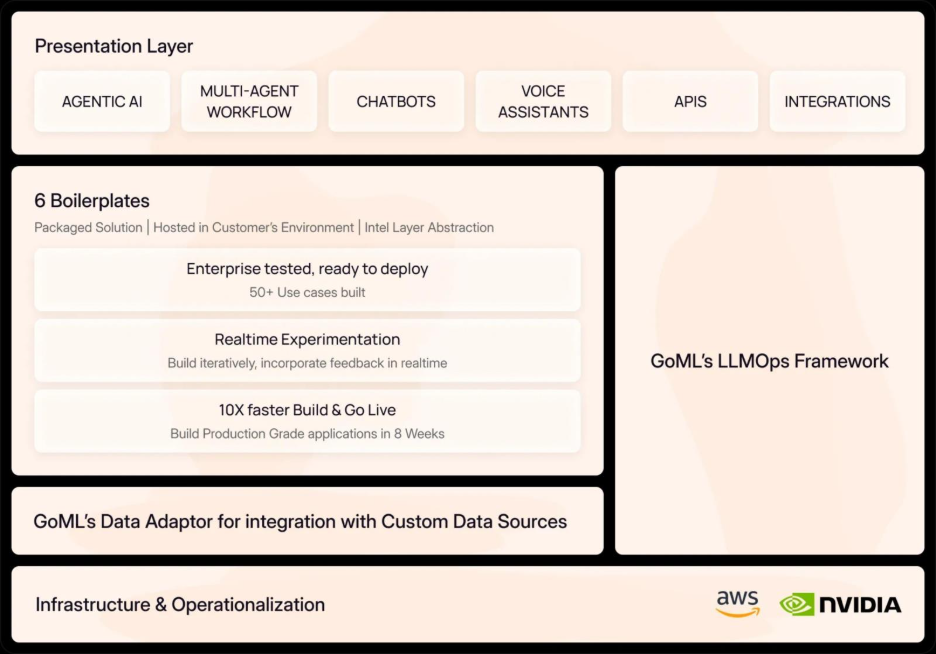
How does AI Matic accelerate enterprise Gen AI adoption?
The AI Matic framework is designed to deliver measurable advantages that fundamentally change the economics and risk profile of AI adoption. With AI Matic, we have been able to take >70% of Gen AI POCs for our clients to production.
Rapid deployment
Ready-to-use accelerators eliminate lengthy experimentation cycles. Organizations move from concept to production in 4-12 weeks rather than 12-18 months. This speed enables faster time-to-value and earlier realization of business benefits.
Built-in risk mitigation
Security, compliance, and reliability guardrails are embedded from inception. Zero-trust architectures with end-to-end encryption protect data at every layer. Comprehensive compliance adherence for SOC2, HIPAA, and GDPR ensures regulatory readiness. This reduces deployment failure risk by 95% compared to traditional methods.
Engineering excellence for Gen AI
Successful AI adoption relies on choosing the right models, mastering prompt engineering, implementing multi-agent frameworks, and designing Gen AI-native architectures to deliver over 95% accuracy and measurable ROI. AI Matic is built specifically for Gen AI engineering and development.
Optimized performance and reliability
Continuous monitoring systems, disaster recovery capabilities, and high-availability architecture ensure enterprise systems remain operational during unexpected failures or peak demand. Robust queueing and batching pipelines maintain performance even when models throttle APIs during high-load periods.
DevOps + LLM integration
AI Matic integrates traditional DevOps practices with machine learning workflows, providing CI/CD pipelines, automated testing, and infrastructure-as-code specifically designed for AI applications.
Future-proofing through continuous innovation
Regular updates incorporating the latest AI frameworks and model advancements ensure accelerators remain current with rapidly evolving technology, avoiding technical debt from outdated foundations.
Six proven use cases for maximizing AI adoption
Based on extensive client engagements, six core use cases represent the majority of enterprise Gen AI requirements. AI Matic includes production-ready accelerators for each:
1. Agentic AI
Use cases: Multi-agent process automation, intelligent workflow orchestration, autonomous business process execution
Business impact: 85% reduction in manual process execution time, 95% improvement in process consistency, 70% reduction in operational costs
Agentic AI enables autonomous systems executing complex business processes with minimal human intervention, freeing teams for strategic work.
2. Content generation
Use cases: Marketing content creation, training material development, operational documentation with compliance enforcement
Business impact: 75% reduction in content creation time, 60% improvement in content consistency, 50% increase in marketing campaign effectiveness
With our AI content generation accelerator, fine-tuned language models generate domain-specific content at scale while maintaining brand voice and compliance standards.
3. Data analytics and insights
Use cases: Real-time business dashboards, anomaly detection systems, predictive forecasting applications
Business impact: 90% faster insight generation, 80% improvement in forecast accuracy, 65% reduction in manual analysis time
High-throughput streaming pipelines and automated model retraining enable organizations to surface insights in real-time with our AI data analytics accelerator.
4. Conversational agents
Use cases: Customer support automation, employee productivity assistance, omni-channel customer engagement
Business impact: 70% reduction in support ticket volume, 50% improvement in customer satisfaction, 40% increase in agent productivity
Sophisticated dialogue management with real-time context awareness creates natural conversations that resolve issues without human escalation.
5. Search engine
Use cases: Semantic enterprise search, RAG-enabled knowledge discovery, intelligent document retrieval
Business impact: 80% faster information retrieval, 60% improvement in decision-making speed, 90% reduction in time spent searching
Advanced indexing and vector databases enable employees to find relevant information instantly using natural language queries.
6. Data synthesis
Use cases: Privacy-safe synthetic dataset generation, testing data creation, compliance-friendly data sharing
Business impact: 95% reduction in data sharing compliance time, 80% improvement in testing data availability, 70% reduction in data privacy risks
Advanced anonymization and generative models create realistic synthetic data for testing without exposing sensitive information.
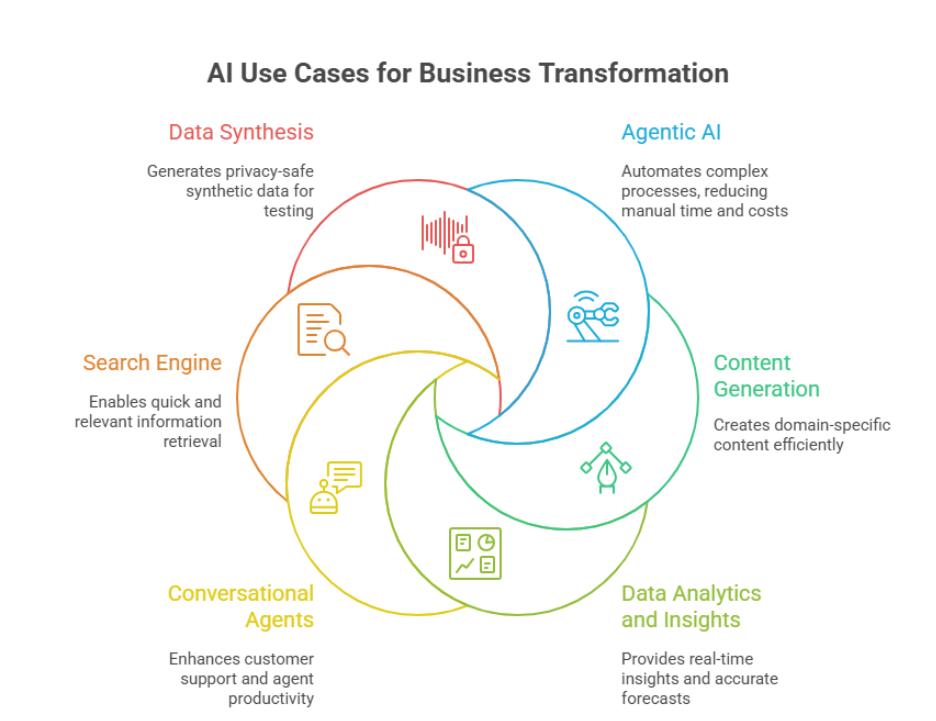
Measure the real ROI of Gen AI adoption
Successful AI adoption requires a clear understanding of costs, benefits, and risk reduction.
Cost-benefit comparison
Traditional POC-to-production approach:
- Timeline: 12-18 months from concept to production
- Investment: $500K-1M+, including infrastructure, development, testing, deployment
- Success rate: 5% reaching meaningful business impact
- Hidden costs: Technical debt, integration challenges, maintenance complexity
AI Matic approach:
- Timeline: 3-4 months from assessment to production deployment
- Investment: Comparable with production-ready architecture included
- Success rate: 95% reaching production with measurable business impact
- Value-added benefits: Future-proof architecture, ongoing innovation, comprehensive support
Quantified improvements
- Time-to-value: 75% faster deployment enables earlier realization of business benefits and competitive advantage.
- Cost reduction: 60-80% lower total investment with dramatically higher probability of success fundamentally changes project economics.
- Risk mitigation: 90% reduction in deployment failure risk through production-first approach eliminates waste associated with failed pilots.
Industry-specific success
- Healthcare: HIPAA-compliant accelerators have enabled 90% faster treatment planning decisions while maintaining patient privacy.
- Financial Services: Regulatory-ready frameworks have driven significant impact, including implementations generating $6M in new revenue through intelligent asset management while maintaining full compliance.
- Life Sciences: Automated audit systems reduced compliance timelines from months to hours, accelerating drug discovery while maintaining rigorous documentation.
- Technology and SaaS: Enterprise-grade accelerators enable secure, scalable deployments with natural-language querying, predictive analytics, and rapid POC-to-production timelines that improve retention and drive revenue growth.
Take action about AI adoption
The data is clear: traditional approaches to AI adoption are failing at alarming rates. Organizations pour resources into pilots that never reach production, wasting investment and missing competitive opportunities.
The production-first paradigm changes everything. By addressing scalability, security, compliance, and integration from day one, organizations can move beyond the 10 - 15% success rate that plagues traditional efforts.
AI Matic provides the proven framework, accelerators, and expertise that enterprise leaders need to bridge the gap between pilot and production. With 50+ successful implementations to production, AI Matic represents a fundamental shift in approach.
The future belongs to organizations that can successfully deploy production-ready AI.
Join 120+ enterprises that have moved beyond failed pilots to production success with measurable business impact using our accelerated AI adoption framework.



